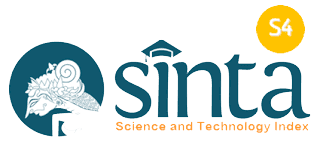Application of the PBL (Problem-Based Learning) Method with the STEAM (Science, Technology, Engineering, Arts, and Mathematics) Approach to Improve Students' Creative Ability in Indonesia
(1) Directorate of Secondary and Special Education Teachers, Ministry of Education, Culture, Research and Technology, Indonesia
(*) Corresponding Author
DOI: https://doi.org/10.26858/pdr.v6i2.44421
Abstract
The Indonesian education system has been criticized for its rote learning approach, which emphasizes memorization rather than the application of knowledge. This study aims to explore the application of the Problem-Based Learning (PBL) method with the STEAM (Science, Technology, Engineering, Arts, and Mathematics) approach to increase students' creativity abilities in Indonesia. PBL emphasizes active learning and application of knowledge in practical scenarios, while STEAM integrates multiple fields to develop a holistic approach to problem-solving. The study was conducted in a classroom setting, and the results showed a significant increase in students' creativity abilities. Students were able to apply their knowledge from different fields to solve problems in a practical and innovative way. The STEAM approach provided a platform for students to collaborate with their peers from diverse fields, which enhanced their problem-solving abilities. Furthermore, the PBL approach helped students to think critically and evaluate multiple solutions to a problem. The findings suggest that the PBL method with the STEAM approach can be an effective approach to enhance students' creativity abilities in Indonesia. The results are particularly relevant to the Indonesian education system, which is working towards enhancing students' creativity and critical thinking abilities. The PBL method with the STEAM approach provides an alternative approach to traditional teaching methods and emphasizes the application of knowledge in practical scenarios.
Keywords
Full Text:
PDFReferences
Adams, E. L. (2021). The effect of a middle grades STEM initiative on students’ cognitive and non-cognitive outcomes. Studies in Educational Evaluation, 68, 100983. https://doi.org/https://doi.org/10.1016/j.stueduc.2021.100983
Andersen, A.-L., & Rösiö, C. (2021). Continuing Engineering Education (CEE) in Changeable and Reconfigurable Manufacturing using Problem-Based Learning (PBL). Procedia CIRP, 104, 1035–1040. https://doi.org/https://doi.org/10.1016/j.procir.2021.11.174
Barth, V. L., Piwowar, V., Kumschick, I. R., Ophardt, D., & Thiel, F. (2019). The impact of direct instruction in a problem-based learning setting. Effects of a video-based training program to foster preservice teachers’ professional vision of critical incidents in the classroom. International Journal of Educational Research, 95, 1–12. https://doi.org/https://doi.org/10.1016/j.ijer.2019.03.002
Chao, C.-T., Tsai, C.-L., Lin, M.-W., Yang, C.-W., Ho, C.-C., Chen, H.-L., Hsu, C., & Sheu, B.-C. (2022). Fully digital problem-based learning for undergraduate medical students during the COVID-19 period: Practical considerations. Journal of the Formosan Medical Association, 121(10), 2130–2134. https://doi.org/https://doi.org/10.1016/j.jfma.2021.11.011
Eltanahy, M., Forawi, S., & Mansour, N. (2020). Incorporating Entrepreneurial Practices into STEM Education: Development of Interdisciplinary E-STEM Model in High School in the United Arab Emirates. Thinking Skills and Creativity, 37, 100697. https://doi.org/https://doi.org/10.1016/j.tsc.2020.100697
Hack, C., McKillop, A., Sweetman, S., & McCormack, J. (2015). An evaluation of resource development and dissemination activities designed to promote problem-based learning at the University of Ulster. Innovations in Education and Teaching International, 52(2), 218–228.
Jaipal-Jamani, K. (2023). Makerspace and robotics as/for STEM education (R. J. Tierney, F. Rizvi, & K. B. T.-I. E. of E. (Fourth E. Ercikan (eds.); pp. 103–111). Elsevier. https://doi.org/https://doi.org/10.1016/B978-0-12-818630-5.13034-9
Kuo, H.-C., Tseng, Y.-C., & Yang, Y.-T. C. (2019). Promoting college student’s learning motivation and creativity through a STEM interdisciplinary PBL human-computer interaction system design and development course. Thinking Skills and Creativity, 31, 1–10. https://doi.org/https://doi.org/10.1016/j.tsc.2018.09.001
Matewos, A. M., Marsh, J. A., McKibben, S., Sinatra, G. M., Le, Q. T., & Polikoff, M. S. (2019). Teacher learning from supplementary curricular materials: Shifting instructional roles. Teaching and Teacher Education, 83, 212–224. https://doi.org/https://doi.org/10.1016/j.tate.2019.04.005
Roehrig, G. H., Dare, E. A., Wieselmann, J. R., & Ring-Whalen, E. A. (2023). STEM curriculum development and implementation (R. J. Tierney, F. Rizvi, & K. B. T.-I. E. of E. (Fourth E. Ercikan (eds.); pp. 153–163). Elsevier. https://doi.org/https://doi.org/10.1016/B978-0-12-818630-5.13056-8
Saad, A., & Zainudin, S. (2022). A review of Project-Based Learning (PBL) and Computational Thinking (CT) in teaching and learning. Learning and Motivation, 78, 101802. https://doi.org/https://doi.org/10.1016/j.lmot.2022.101802
Sierra, J. (2020). The potential of simulations for developing multiple learning outcomes: The student perspective. The International Journal of Management Education, 18(1), 100361. https://doi.org/https://doi.org/10.1016/j.ijme.2019.100361
So, W. W., & Guo, C. (2023). Community engagement in STEM education (R. J. Tierney, F. Rizvi, & K. B. T.-I. E. of E. (Fourth E. Ercikan (eds.); pp. 234–243). Elsevier. https://doi.org/https://doi.org/10.1016/B978-0-12-818630-5.13006-4
Sua, T. Y., Ngah, K., & Darit, S. M. (2013). Parental choice of schooling, learning processes and inter-ethnic friendship patterns: The case of Malay students in Chinese primary schools in Malaysia. International Journal of Educational Development, 33(4), 325–336. https://doi.org/https://doi.org/10.1016/j.ijedudev.2012.09.002
Syam, A., Hasbiah, S., Yunus, M., & Akib, H. (2018). Determinants of entrepreneurship motivation for students at educational institution and education personnel in Indonesia. Journal of Entrepreneurship Education, 21(2).
Utomo, T., Wahyuni, D., & Hariyadi, S. (2014). Pengaruh Model Pembelajaran Berbasis Masalah (Problem Based Learning) Terhadap Pemahaman Konsep dan Kemampuan Berpikir Kreatif Siswa (Siswa Kelas VIII Semester Gasal SMPN 1 Sumbermalang Kabupaten Situbondo Tahun Ajaran 2012/2013). Jurnal Edukasi, 1(1), 5–9.
Wannapiroon, N., & Pimdee, P. (2022). Thai undergraduate science, technology, engineering, arts, and math (STEAM) creative thinking and innovation skill development: a conceptual model using a digital virtual classroom learning environment. Education and Information Technologies, 27(4), 5689–5716. https://doi.org/10.1007/s10639-021-10849-w
Article Metrics
Abstract view : 392 times | PDF view : 39 timesRefbacks
- There are currently no refbacks.
Copyright (c) 2023 Sumarno Sumarno


































